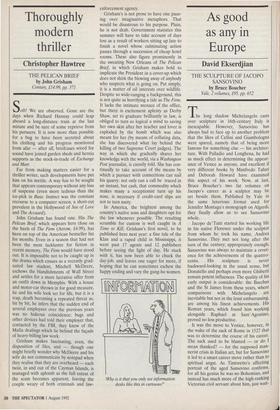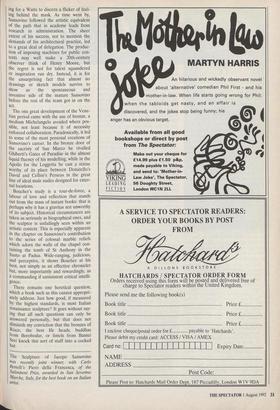As good
as any in Europe
David Ekserdjian
THE SCULPTURE OF JACOPO SANSOVINO by Bruce Boucher Yale, 2 volumes, £95, pp. 652 The long shadow Michelangelo casts over sculpture in 16th-century Italy is inescapable. However, Sansovino has always had to face up to another problem that the likes of Cellini and Giambologna were spared, namely that of being more famous for something else — his architec- ture. With Palladio and Longhena, he had as much effect in determining the appear- ance of Venice as anyone, and excellent if very different books by Manfredo Tafuri and Deborah Howard have examined this aspect of his work. Now, at last, Bruce Boucher's two fat volumes on Jacopo's career as a sculptor may be set beside them. Published by Yale in the same luxurious format used for Jennifer Montagu's monograph on Algardi, they finally allow us to see Sansovino whole.
Jacopo de'Tatti started his working life in his native Florence under the sculptor from whom he took his name, Andrea Sansovino. They met not long after the turn of the century; appropriately enough, Sansovino was always to maintain a rever- ence for the achievements of the quattro- cento. His sculpture is never backward-looking in the usual sense, but Donatello and perhaps even more Ghiberti remain potent influences. The quality of his early output is considerable: the Bacchus and the St James from these years, where comparisons with Michelangelo are inevitable but not in the least embarrassing, are among his finest achievements. His Roman years, which found him working alongside Raphael at Sant' Agostino, proved no less productive.
It was the move to Venice, however, in the wake of the sack of Rome in 1527 that was to determine the course of his career. The sack used to be blamed — or do I mean thanked? — for the supposed man- nerist crisis in Italian art, but for Sansovino it led to a smart career move rather than to spiritual angst. As Tintoretto's affecting portrait of the aged Sansovino confirms, for all his genius he was no Bohemian, and instead has much more of the high-ranking Victorian civil servant about him, just wait- ing for a Watts to discern a flicker of feel- ing behind the mask. As time went by, Sansovino followed the artistic equivalent of the path that in academe leads from research to administration. The sheer extent of his success, not to mention the demands of his architectural practice, led to a great deal of delegation. The produc- tion of imposing machines for public con- texts may well make a 20th-century observer think of Henry Moore, but the regret is not for talent squandered or inspiration run dry. Instead, it is for the unsurprising fact that almost no drawings or sketch models survive to show us the spontaneous and inventive side of the mature Sansovino before the rest of the team got in on the act.
The one great development of the Vene- tian period came with the use of bronze, a medium Michelangelo avoided where pos- sible, not least because it of necessity enforced collaboration. Paradoxically, it led to some of the most personal creations of Sansovino's career. In the bronze door of the sacristy of San Marco he rivalled Ghiberti's Gates of Paradise in the almost liquid fluency of his modelling, while in the Apollo for the Loggetta he cast a statue worthy of its place between Donatello's David and Cellini's Perseus in the great line of ideal male nudes designed for exter- nal locations.
Boucher's study is a tour-de-force, a labour of love and reflection that stands out from the mass of instant books: that is perhaps why it has a gravitas not unworthy of its subject. Historical circumstances are taken as seriously as biographical ones, and the sculptor is unfailingly seen within an artistic context. This is especially apparent in the chapter on Sansovino's contribution to the series of colossal marble reliefs which adorn the walls of the chapel con- taining the tomb of St Anthony in the Santo at Padua. Wide-ranging, judicious, and perceptive, it shows Boucher at his best, not simply as an effective chronicler but, more importantly and rewardingly, as a commanding if uninsistent critical intelli- gence.
There remains one heretical question, which a book such as this cannot appropri- ately address. Just how good, if measured by the highest standards, is most Italian renaissance sculpture? It goes without say- ing that all such questions can only be answered personally, but that does not diminish my conviction that the bronzes of Riace, the best Ife heads, buddhas from Borobodur, or lintels from Bantei Srei knock this sort of stuff into a cocked hat.
The Sculpture of Jacopo Sansovino was recently joint winner, with Carlo Bertelli's Piero della Francesca, of the Salimbeni Prize, awarded in San Severino Marche, Italy, for the best book on an Italian artist.



















































 Previous page
Previous page